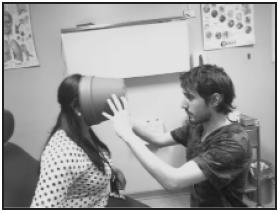
Introducción: La prueba Visual Subjetiva Vertical (SVV por sus siglas en inglés) corresponde a una prueba de bajo costo y complejidad que permite el estudio de la función vestibular "estática". En el año 2009 se valida la Prueba del Balde con igual confianza, sensibilidad y especificidad, que la prueba de domo. Sin embargo, diversos factores impresionan disminuir su precisión. Objetivo: Proponer un nuevo método utilizando un programa computacional y una interfaz pantalla-paciente, que permita disminuir la influencia de variables y aumentar la precisión de la evaluación. Material y método: En 43 voluntarios sin historia de patología vestibular y en 32 pacientes con patología vestibular se compararon los resultados de la aplicación de SVV en dos modalidades: prueba del balde tradicionalyuna prueba computarizada propuesta en el presente artículo. Resultados: En nuestro estudio el SVV con balde muestra 57% de sensibilidad y 90% de especificidad, mientras el SVV digital tiene 74% de sensibilidad y 93% de especificidad, el cual también presentó significativamente una menor desviación estándar. Conclusión: En suma, el SVV computarizado arroja un resultado más preciso que SVV con balde, con mejor utilidad clínica al tener mayor de discriminación con mejores perfiles de sensibilidad/especificidad.
Background: Subjective Visual Vertical Test (SVV) is a low-cost and simple evaluation that allows the physician to study the static vestibular function of a patient. In 2009 the Bucket Test was validated as a high confidence, sensitivity and specificity comparable to the hemispheric dome testing device. Although, its result can be affected by multiple variables. Aim: To propose a new method to evaluate SVV using a computer software interface, that allows a reduction ofvariables therefore increasing its precision. Material and method: In a sample of 43 volunteers with no previous history of vestibular pathologies and 32 patients with diagnosed vestibular pathologies we compared the results of 2 different modules of SVV testing: a traditional bucket test and a computerized test proposed in the present article. Results: Bucket test SVV for this research showed a sensitivity of 57% and a specificity of 90%, meanwhile Computerized SVV had a sensitivity of 74% and a specificity of 93%, which also presented a significant smaller standard deviation. Conclusion: In summary, digital SVV testing grants more accurate result in comparison to the Bucket Test, with a better clinical performance due to an improved discriminatory capacity with better Sensitivity/Specificity profiles.
http://ift.tt/2v13O9w

Δεν υπάρχουν σχόλια:
Δημοσίευση σχολίου